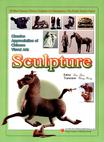中国视觉艺术经典欣赏
2012-3
宁夏人民出版社
乔迁
63
30000
王瑢
乔迁编著的《中国视觉艺术经典欣赏(雕塑)》汇编的经典视艺术雕塑的概况和描绘的细节,其中不仅注重科学性和知识取向。但也有搞笑和娱乐功能的书法作品都已经化最高的中国雕塑作品,申请人的简单和易於—了解大量美丽的插图,本书还介绍了众多的艺术知识和历史知识通过大量的相关知识。
You with Pattern of Tiger Eating A Man
Sanxingdui Bronze Facial Mask
Copper Venal Basemade ofInlaid Gold and Silver with Pattem of Tiger
Eating Dee
The Fit Qin Emperor’s Terracotta Army
Drum—beating,Talking and Singing Figurine
Copper Galloping Hoe
Stone Bide
Stone Plinth of Tomb of Sima Jinlong
BodhJsattva Statue of Qingzhou
Statue of Saluzi and Oiu Xinggong
Nishyanda Buddha
Giant Stone Buddha of Leshan
Standing Statue of Vaisravana
Statue of Ananda
Three—colored Standing Female Figurine
Standing Statue of Arhat
Statue of Donator
Statue of Maid in Jinci Temple
Statue of Gift Raising Chicken
Clay Sculptures of Children
Standing Statues of Bodhisattva in Lower Huayan Temple
Sun Rat of Emptiness
Silver Cha Cup
Standing Statue of Bodhidharma
Statue of Guan Yu
Brick Carving for Juyi Hall of Mount Liang
Dialogue Between Fisherman and Woodcutter
Sculpture entitled Meditation
Sculpture entitled”Arduous Yea
Peace Girl
版权页: 插图: This stone carving is a part of coffin chamber, which is lower pedestal of a stone column. It is unearthed from ancient tomb in Shijiazhai Village,and its owner is Sima Jinlong,Zhenxi General in the Northern Wei Dynasty. Stone Plinth of Tomb of Sima Jinlong consists of three layers from top to bottom. The base is square, with honeysuckle and intertwining lotus pattern cut in relief at four sides. Every unit design sees a dancing child with different actions,which is changing and uniform. The middle layersees high relief of dragon crossing the sea, which is surrounded by dancers with different postures.The top layer sees a blooming lotus. This artwork boasts brilliant shape, and makes clever use of round carving, openwork carving, line engraving and other carving techniques. Round carving, openwork carving and line engraving are all carving techniques. Round carving refers to carving at all aspects and all parts so that artworks have no background to be appreciated from various angles. Openwork carving refers to engraving relief board hollow so that backside scenery can be seen from openwork place through obverse side of artworks. Line engraving refers to outlining the scenery with brush on the material, and then engraving concavoconvex lines along the ink with sharp knife instead of brush. The Wei and Jin Dynasties and the Northern and Southern Dynasties witnessed the golden age of traditional sculptures. Due to interactions between various ethnic groups, sculpture style diversified in this period. Buddhismthemed artworks dominated in terms of quantity. As for the creation, "charm" was highlighted, while drawing and realism were reinforced. Building sculptures refer to local decorations or building components which are used to beautify main parts of buildings,Round carving, openwork carving, line engraving and other carving techniques are often adopted on the building surface so as to create a variety of art images. Ancient building sculptures form respective systems and show strong ethnic features.They are widely used in screen wall facing the gate of a house, marble pillar, plinth,architrave, caisson, tile, etc. Bodhisattva Statue of Qingzhou is one of preserved statues of Longxing Temple,Qingzhou, Shandong. As a masterpiece of the Wei and Jin Dynasties and the Northern and Southern Dynasties, it marks the highest achievement of Buddha statue at that time. The hands and legs of Bodhisattva statue are missing, but the statue is still beautiful. Bodhisattva features clear facial features, slight smile,slender body and elegant posture.She wears a crown with drooping strip. She wears a long skirt and short embroidered cape on shoulder. She is covered by luxurious and refined pendants, with well-proportioned image. With saint, elegant, implicit and ordinary features, the statue is not only resplendent with jewels, but also presents plain and pure temperament. In recent years, in the cellar of Longxing Temple Site in Qingzhou, Shandong, a total of 2,000 preserved Buddha statues and statue steles are found. They boast high artistic level and good preservation conditions. They can date back from the Northern Wei Dynasty to the Song Dynasty,and most ofthem are treasures of the Northem Wei Dynasty and the Northern Qi Dynasty.They are made of limestone,granite, marble, cast iron,pottery, clay, wood, etc.
